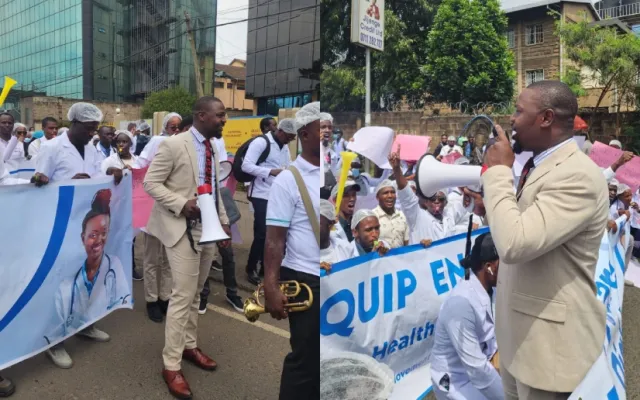The national secretary general of the Kenya Medical Practitioners, Pharmacists and Dentists Union (KMPDU) Davji Bhimji Atellah has condemned the Inspector General of Police Japhet Koome for terming striking medics a public nuisance.
This comes hours after Koome accused the medics of disrupting public order during demonstrations in various cities and towns. According to Atellah, the statement by Koome undermines Kenyans' rights to assemble, demonstrate and present petitions enshrined in Article 37 of the Constitution.
"Undermining the constitutional rights of citizens to assemble,
"The National Police Service takes cognizance of the ongoing doctor's strike, with utmost concern. The Service has witnessed and received reports of the inconveniences arising from the strike, with medics lying on the streets thus obstructing highways, public roads and disrupting the free flow of vehicles and movement of people," Koome stated.
"The medics have become a public nuisance, blowing whistles and vuvuzelas during the demonstrations thus causing discomfort to patients in hospitals and the general public."
Koome says that the medics have been holding their demonstrations without notifying the police, which allows non-medics to join the processions to cause havoc and terror to the public.
"Contrary to the Constitutional provisions on the right to picket, petition or demonstrate, the medics continue to engage in demonstrations without notifying the Police. Yet, we have information that non-medics with the intention to cause havoc and terror to the public intend to join the ongoing processions, a move that poses a threat to public safety and security," Koome added.
Koome has directed police commanders to deal with the situations firmly, decisively and under the law. He, however, did not reveal whether the police would disrupt the medics' demos henceforth.
"In the interest of national security, therefore, all respective police commanders have been instructed to deal with such situations firmly and decisively in accordance with the law. We wish to caution all doctors to refrain from infringing on the rights of others while demonstrating, and that their efforts to disrupt the smooth operations of hospitals will not be tolerated. We wish to assure the public that our Country is safe and that the National Police Service remains committed to maintaining law and order," he added.
Medics' demos on Monday
The doctors, through the Kenya Medical Practitioners, Pharmacists and Dentists Union (KMPDU), will hold demonstrations at the Mediheal Hospital in Eldoret.
"Join the KMPDU North Rift branch, on April 15th 2024 at 8:30 am for a peaceful demonstration at Mediheal Hospital. We advocate for our rights, full implementation of the CBA, and improvements in the healthcare system," KMPDU stated on X (formerly Twitter).
The health crisis in Kenya continues to deepen with the doctors' strike gitting the 33rd day, while that by clinical officers hits a fortnight on Sunday, April 14.
Doctors have been on strike since March 14, 2024, over pay and working conditions. Clinicians joined them on April 1, 2024.
Talks between KMPDU, the Kenya Union of Clinical Officers (KUCO) and the government have hit a dead end with little progress made. By Francis Muli, People Daily






